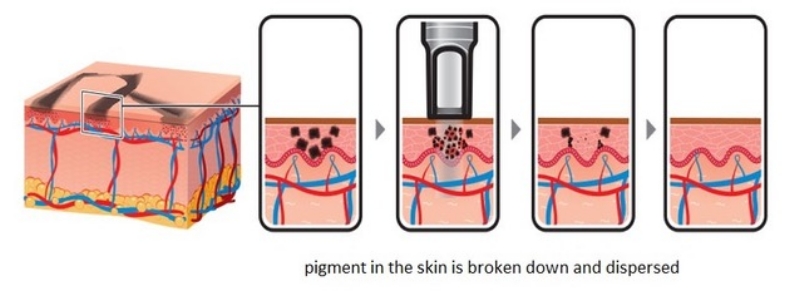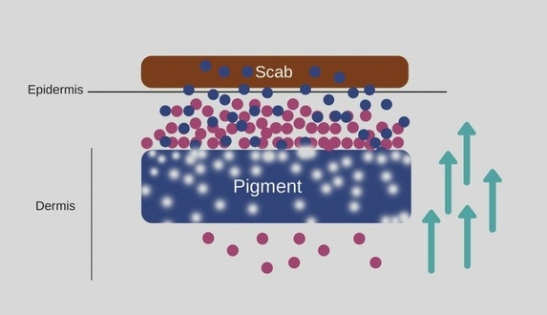Both saline and laser are well-respected methods of removal. Both can be amazingly effective and provide the results you are hoping for. Saline and laser couldn’t be more different so how do you know which method would be best and most effective for you and your particular case? The information listed here will hopefully provide some insight and help you to choose the method of removal that will best suite your needs.
Laser works by producing a short pulse of intense light that penetrates deep enough down into the skin, then is absorbed by the pigment.
The intense light breaks up the pigment into tiny fragments. The laser pushes the tiny fragments back down, deeper into the body to be removed by the body’s lymph and waste system. Different laser wavelengths target specific colors at specific depths in the skin. It can take several laser wavelengths to remove a multi-colored tattoo. Due to the variables and restrictions of many lasers, it is important to do your research and pick the right laser for the tattoo you want removed.
The healing process is about 7 to 10 days. With some lasers, you may experience blisters, if so that could prolong the healing process.

Saline works by Osmosis. The high concentration of salt draws the water underneath and surrounding the pigment up to the surface of the skin to be contained and removed by the scab. So, whereas Laser pushes pigment back down into the body to be removed by the lymph and waste system, saline moves the pigment up and out of the skin via the scabbing process. Saline is not color restricted and will remove all colors including white (titanium dioxide). Saline is also not depth specific, meaning it will target and start lifting pigment/ink no matter the depth that it resides.
Li-FT® Saline solution is delivered into the skin in the same way we implant pigment or ink to do a permanent makeup or body tattoo procedure. We use our tattoo machines; dip our tattoo needle into the Li-FT® solution and then tattoo it into the area of the unwanted procedure or tattoo.

The healing process is about 7 to 10 days. Saline removal does not cause any blistering.
Laser can permanently remove brow hair. Saline will not affect your eyebrow hair at all. If you have badly tattooed eyebrows you wish to remove AND you have brow hair present, saline pigment removal would be your best choice. Laser can and in many cases has permanently removed the brow hair. Saline pigment removal will not affect your brow hair at all.
Tattooing skin after it has been lasered is often unsuccessful. Saline removal tends not to affect the skin in this way and any plans to re-do the procedure or tattoo is successful. Due to the scar tissue and process of the laser, it will often leave the skin in a condition where it will no longer accept pigment/ink…or not very well. If after you successfully remove the unwanted procedure or tattoo, you would like to re-do the procedure or tattoo, I would consider choosing saline pigment removal. Saline removal
Laser notoriously does not remove white (titanium dioxide). Saline removal does not recognize color but rather pigment uniformly so it can be highly effective in removing all colors including white. When laser makes contact with white, it can turn it dark gray or black. Saline pigment removal is not color restricted in that way. Saline recognizes color uniformly and therefor can be effective in the successful removal of white.
Laser cannot be used around the eyes. Li-FT® saline solution is safe and effective in removing poorly done eyeliner tattoos. If you have an eyeliner you are considering for removal, saline will be your choice. Many lasers are not approved to be used around the eye area, and only a doctor should be performing laser removal around the eye area.
Laser cannot be used on the lips. Li-FT® saline solution is safe and effective in removing poorly done lip tattoos. If you have tattooed lips you would like to lighten or remove, saline -will be your choice. Lasers cannot be used on the lip tissue to remove unwanted pigment/ink.
Laser hurts like heck. The saline removal procedure can be uncomfortable, but it is tolerable. The short pulse of intense light produced by the laser hurts like heck, even when a topical anesthetic is used. Laser feels like a super-hot, elastic band snapping against your skin. The saline removal process can be uncomfortable, but it is tolerable. We are simply tattooing the Li-FT® Saline Solution into your skin just like we do with a permanent makeup or body tattoo procedure. The only difference is we are dipping in the Li-FT® Saline Solution instead of pigment/ink. A high-quality topical numbing cream is used throughout the procedure and for most clients the process is very tolerable.
Both Saline and Laser are relatively close in cost. There tends to be a wide range in cost with both laser and saline removal. The cost will depend on the size of the area to be removed and is at the discretion of the laser and/or saline removal technician.
Laser is going to cover the surface area of a large tattoo much quicker and more efficiently than the saline removal technique. Saline removal will take much longer to remove a large tattoo. The laser wand can cover a large surface area quickly and efficiently compared to the saline removal method. Since we use tattoo needles and tattoo techniques with the saline removal process, it will take much longer to cover a large tattoo. If the tattoo is big enough, it may even need to be removed in sections if using the saline removal method. If you have a large body tattoo you want to remove, then laser will be your best choice.